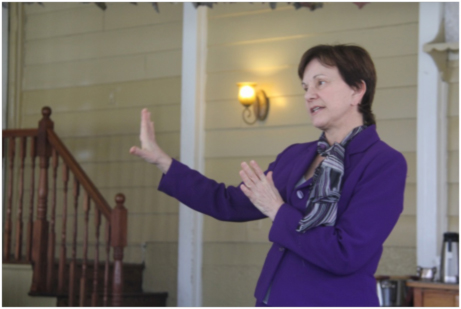
- This event has passed.
FDAAA Luncheon with FDA CDER Center Director, Janet Woodcock, MD, April 2, 2015
April 2, 2015
By: Jayne Ware

The FDA Alumni Association celebrated Spring on April 2nd with an outstanding luncheon, featuring lively fellowship and a favorite FDA speaker. Over 35 FDAAA members attended the luncheon at Mrs. K’s Toll House in Silver Spring, Maryland, and received a treat: a visit with Dr. Janet Woodcock, Director of the Center for Drug Evaluation and Research (CDER). For more than a decade, Janet has been highlighting the need for an overhaul of pharmaceutical quality regulation and seeking buy-in and alignment from leadership in other corners of the Agency. Janet was happy to report that a key piece of that overhaul is in place: an organizational transformation of the Center’s business units involved in regulating drug quality. The transformation (a.k.a. an “administrative nightmare”) involved a reorganization, consolidating the pharmaceutical quality functions previously housed in the Office of Pharmaceutical Science, the Office of Generic Drugs, the Office of Manufacturing and Product Quality, and the Office of Compliance, into a single organization.

In her unique style and with her extraordinary perspective, Janet provided an informative and entertaining explanation of the structure and purpose of CDER’s newly-formed “super” office – the Office of Pharmaceutical Quality (OPQ).
The reorganization, affecting over 1000 CDER staff, is now approved and in place, though currently led by an interim set of acting directors. Janet, herself, is the current Acting Director of OPQ, and she shared that there is a broadly-scoped recruiting effort to permanently fill the OPQ leadership positions.
Janet spent just a few minutes describing the current state of quality regulation, sharing anecdotes about what needed to be fixed…and why. She focused most of her remarks on the desired state – a condition where the pharmaceutical industry is held accountable for owning and ensuring pharmaceutical quality, and the FDA fills the role of auditor, using a risk-based approach and sound metrics and data speaking with “One Quality Voice.”

The principles behind “One Quality Voice” include: putting patients first by balancing risk and product availability; ensuring a lifecycle approach to regulating quality; ensuring the same quality standards for all drugs; having clear standards for review and inspection; and using team-based reviews to integrate review and inspection when assessing quality.
Janet explained that in addition to the significant organizational transformation, CDER has been able to leverage the influx of financial resources from Generic Drug User Fees to modernize the information technology supporting regulation of pharmaceutical quality. In the last few years, CDER has been able to launch a “Pharmaceutical Platform” to serve as the primary resource for information about drug manufacturing facilities and give the Agency new capability to track surveillance information for each facility, including data about field alerts, 483s, adverse events due to quality issues, and other audit data. With this collection of information about each facility, FDA will now be able to better target its finite enforcement resources and apply a data-driven risk-based model to identify and inspect at-risk facilities.

Janet also explained that another significant focus has been to strengthen partnerships with the ORA field staff to ensure the Agency’s “One Quality Voice.” An example of this partnership includes the team-based reviews that give inspectors opportunity to understand the context within which they are conducting their inspections. Also, CDER and ORA now share access to facility information through the Pharmaceutical Platform rather than operating in separate systems. ORA has also agreed to have specialized pharmaceutical inspectors and has been able to increase the size of the inspectorate.
While Janet was able to report remarkable progress in the last few years in transforming the regulation of pharmaceutical quality, she was clear that much more work needs to be done. Both CDER and ORA will continue to focus on addressing cultural changes, working effectively in teams, attracting and hiring individuals into key leadership positions, ensuring collection of reliable facility data, effectively using that data to make informed regulatory decisions, and most importantly, speaking with “One Quality Voice.”

